Lecture 16: The Corpus Callosum and the Split-Brain
1/24
There's no tags or description
Looks like no tags are added yet.
Name | Mastery | Learn | Test | Matching | Spaced |
|---|
No study sessions yet.
25 Terms
Function of Corpus Callosum:
transfer and integration of information between the two hemispheres
interhemispheric communication
Other commissural fibres
anterior commissure: connects anterior temporal areas and amygdalas
hippocampal commissure
posterior commissure: connects subcortical areas
Parcellation of the corpus callosum
Witelson parcellation: from work with monkeys and clinical work with humans
divides the CC into roughly equal parts corresponding to the functional organization of each section.
CONSIDERABLE overlap
can refine parcellation via diffusion imaging, parcellated into 25 areas, allows to see gradual distribution of where axons go. confirmed with diffusion imaging study with monkeys; tracers injected in terms of which functional areas are connected via the CC, showed the same correspondence as in diffusion imaging.
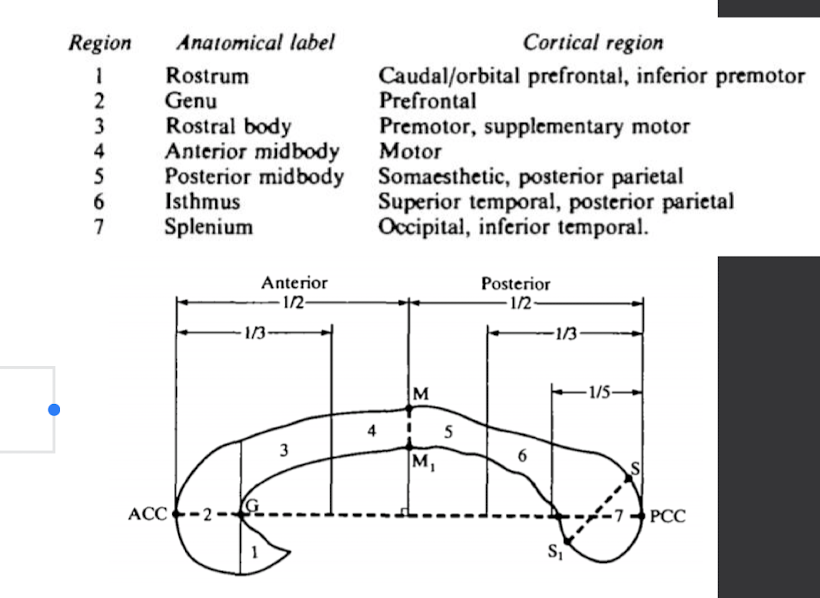
Two hemispheres working together:
motor coordination:
language: left hemisphere is for speaking, right hemisphere is for prosody, music, emotional aspects of language. need the two hemispheres to work together to interpret everything.
emotion processing: facial expressions, regulation/managing emotions.
corpus callosum differences and abnormalities:
normal variations in population:
sex: some areas of CC are larger in women than in men
CC is larger in left handed
Acquired abnormalities:
callosotomies
TBI
strokes
Developmental abnormalities:
CC agenesis
variations in developmental disorders (ex: autism)
Split brain historical background:
19th: wernicke, dejerine and others were aware of inter hemispheric communication essential for high-order functions
split brain experiments on animals and patients with section of the CC
Geschwind, 1965: disconnection syndrome in animals and man based on lesion studies
Sperry, Bogen and Gazzaniga, 1969: interhemispheric relationships: syndromes of hemispheric disconnections
Roger Sperry’s Split brain experiments:
mainly on cats and monkeys: discovered that when you cut the connections between two hemispheres, each hemisphere functions independently as if it were a complete brain.
train one side of the brain to complete task, other brain doesnt know anything about it.
divide optic chiasm so visual info is only presented to one hemisphere
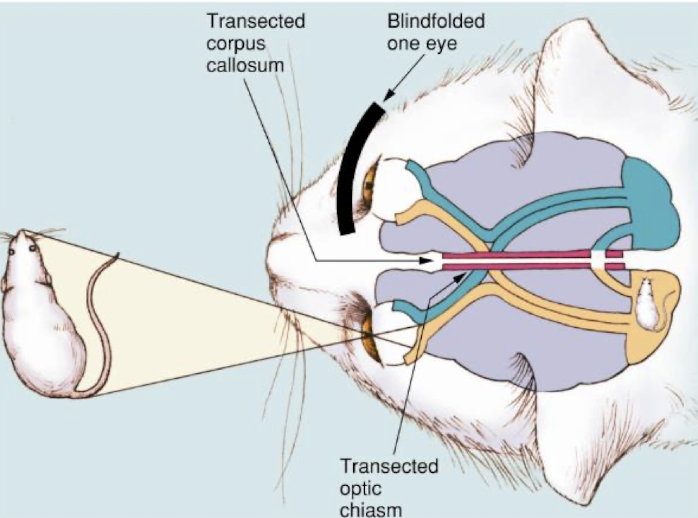
if you cut the CC and the optic chiasm: only the info from one eye is transmitted to one hemisphere.
blindfold the other eye, can teach task to one hemisphere only, then more the eye patch to the other eye: no effect from learning from the other eye.

Split-Brain Roger Sperry
studied the functional specialization of each hemisphere.
performed surgery to cut CC on epileptic patients, first observation: no apparent cognitive damage. but with proper experiments, were able to find specific deficits.
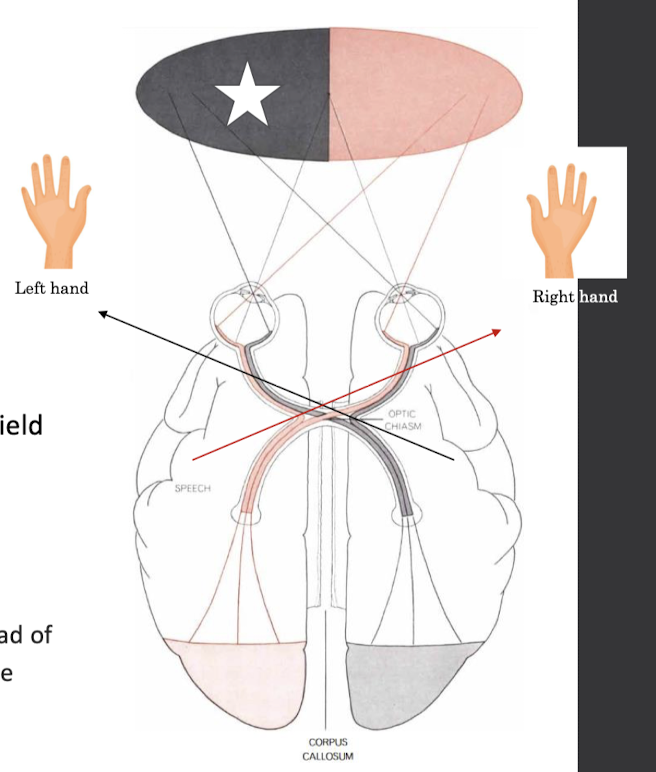
Sperry human cases Example 1: visual stimulation
used short flash (shorter than reflex time).
light flashed in both left and right visual hemisphere field:
what did you see? light flashing in right hemisphere
light flashed only in left hemifield:
what did you see? deny seeing lights
ask them to point to where the lights were flashed: point to correct side.
WHY? speech is in left hemisphere.
Sperry human cases Example 2: tactile stimulation/discrimination test
object in right hand: able to name and describe it
object in left hand: not able to name/describe but able to match it to the same object in a collection of objects presented visually. would be able to sense there is something in their hand tho.
Sperry human case Example 3:
picture/written info flashed in one hemifield OR object placed out of view in one of the patient’s hand.
if presented to left hemisphere (right visual hemifield), able to name and describe verbally or writing.
if presented in left hand/ left visual hemifield: can’t name it but able to give non-verbal answer
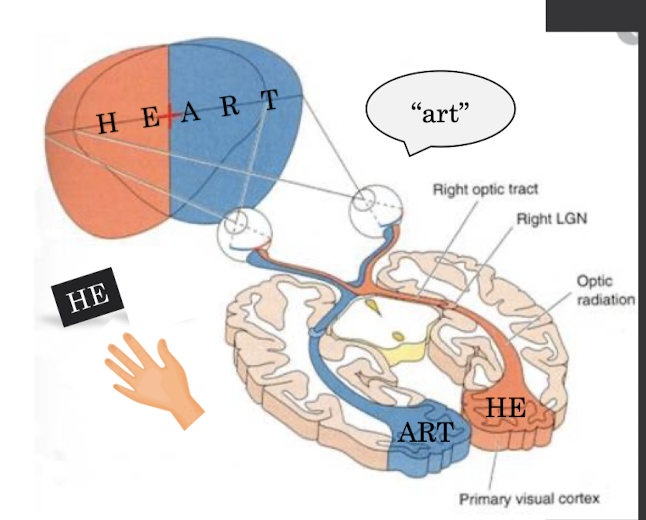
Sperry human cases Example 4:
What is the word? Art
Point with left hand to one of two cards with either HE or ART on it: point to HE
conclusion: both hemispheres see a different portion of the word.
Dichotic listening tasks:
Normal controls: when asked what they heard, usually report what they heard from the right ear: DOMINANCE (wernicke’s in left hemisphere), but if asked specifically what they heard from left ear they can answer (selective auditory attention)
Patients with section of CC: deficits to name what is presented to left ear.
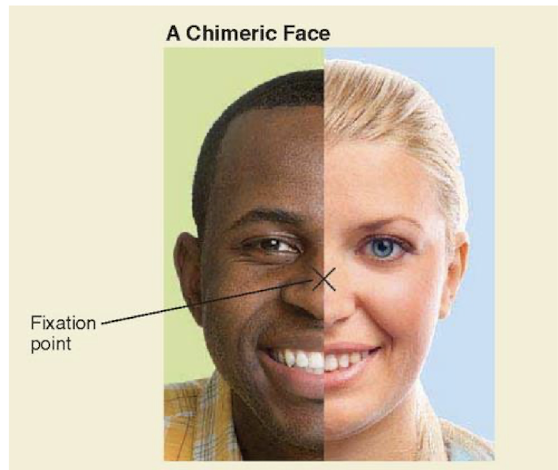
Chimeric face test:
if patient asked what they saw: woman
asked to point with left hand: point to man
both hemispheres think they saw a full face, not like hemineglect
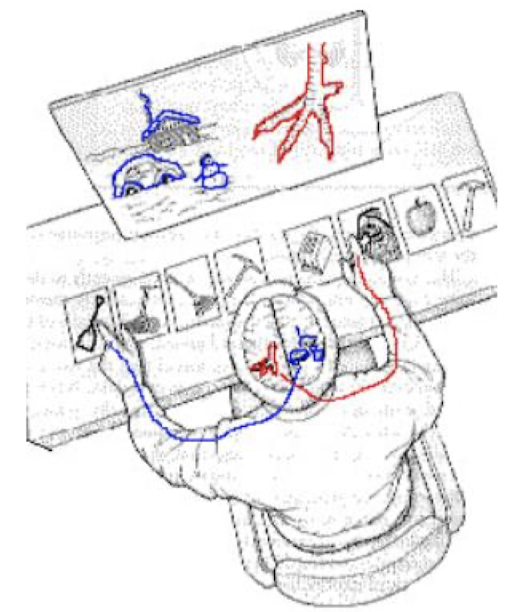
Sperry human cases Example 5: left hemisphere interpreter
Show two pics, one in each hemisphere
patients have to point with two hands at pictures of two objects corresponding to the images seen.
left: points to snow shovel
right: points to chicken
asked why left hand is pointing to shovel: to clean out chicken shed
Generating emotional reactions
Experiment:
present funny pic to the right hemi, patient says she saw nothing when asked, but she smiled and chuckled. why are you laughing? dont know.
right hemi cant verbally describe what was seen but emotional reaction is there. left hemi didnt see the picture so cant say what it is.
Positive symptoms:
split brain patients can:
draw different pics with each hand simultaneously
do visual search tasks faster than controls
Working simultaneously
helping hand phenomenon: right hand knows the answer may try to correct the left hand
cross-cuing: some language abilities in right hemi, some basic language comprehension. if left hemi gives the wrong verbal answer, the right can try to correct it via non-verbal way
Cross-cuing:
present green or red flash to right hemi: patient answers at chance level at first but improves when second guess is allowed.
Why?
correct answer guessed by chance (from left speaking hemisphere), patient sticks to it
wrong answer: right hemi hears the left semi’s wrong guess, cues the left hemi that its incorrect by frowning or by shake of the head.
Working simultaneously:
experiment in monkeys; present something separately to each hemisphere at the same time.
left eye: press the button with the cross, given food
right eye: press the button with the circle: given food.
learned those two associations in the same time it takes normal monkey to learn one.
when CC is sectioned; evidence that each hemisphere acts as one brain.
Lateralization of functions:
contralateral motor control but left hemisphere is dominant for both the planning and execution of movement (right handed individuals better with right hand)
left hemi: language and speech
right hemi: music, emotional processing, visuospatial, processing
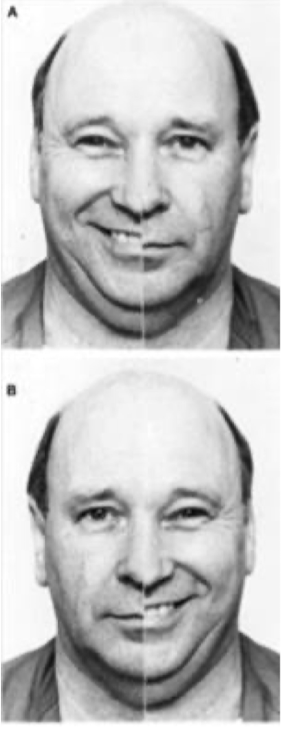
Facial expression:
in normal individuals:
asked which face is most expressive: ppl say pic where left side is more expressive bc right hemisphere is better at processing emotions
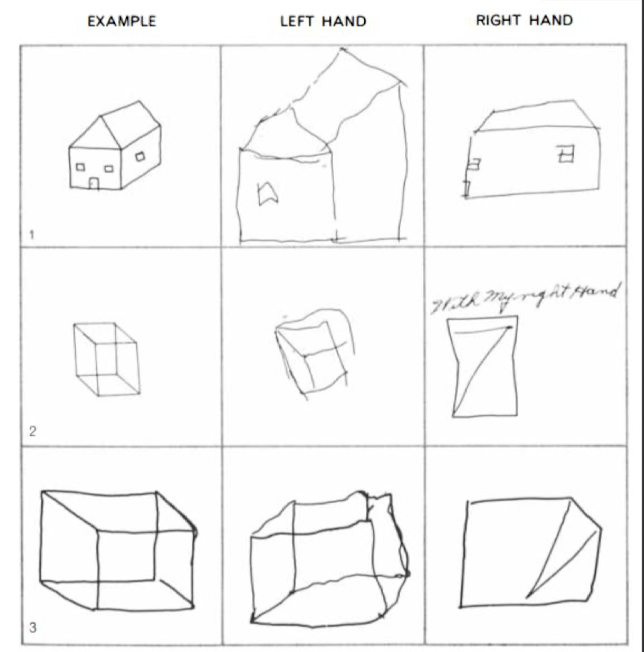
Right hemisphere: visual constructional tasks
visual-constructional tasks, right hemi is better
split-brain patients: when asked to draw an example, even if right handed, patient is better with left hand.
Right hemisphere: spatial awareness
Block design task: better performance with left hand